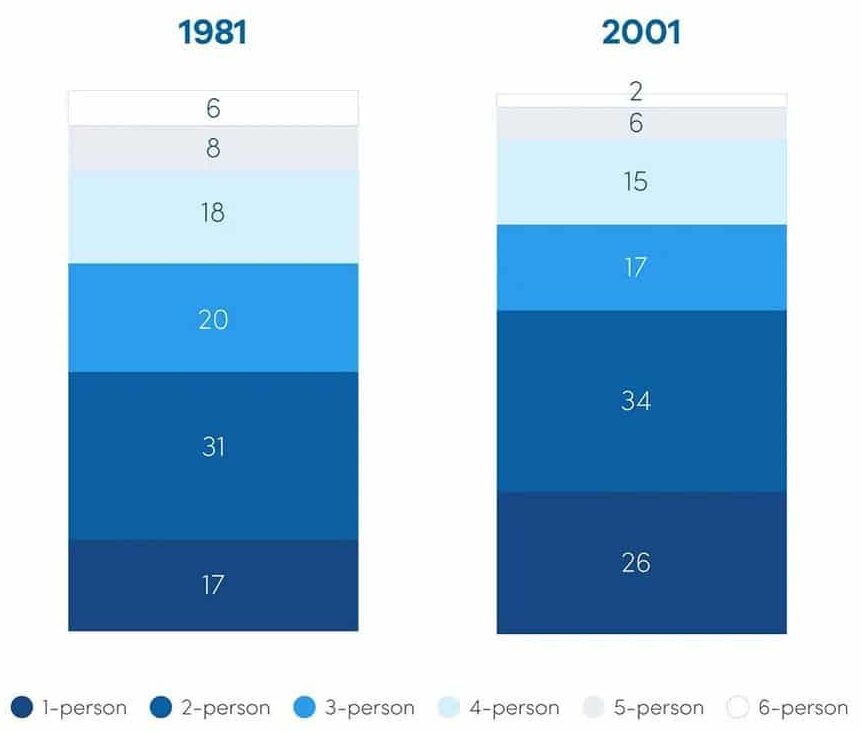Number of People per Household in the UK in 1981 and 2001 – IELTS Academic Writing Task 1
You should spend about 20 minutes on this task.
The chart compares the number of people per household by percentage in the UK in 1981 and 2001.
Summaries the information by selecting and reporting the main features, and make comparisons where relevant.

Write at least 150 words.
Real IELTS Exam Question, Reported On:
| India | 23rd April 2022 |
Practice with Expert IELTS Tutors Online
Apply Code "IELTSXPRESS20" To Get 20% off on IELTS Mock Test
Number of People per Household in the UK in 1981 and 2001
Sample Answer 1
The bar chart details percentages for the number of people living in households across a twenty year period beginning in 1981 in the UK. Looking from an overall perspective, it is readily apparent that the households with more people declined and the reverse was true of smaller homes. The middle groups were the only exceptions to this with increases for 4 people homes and declines for 3 person homes.
The overall leaders in both time periods belonged to 1 and 2 people households. Both increased by 3%, finishing the time surveyed at 26% for the former and 34% for the latter. This contrasted with 5 person households (falling by a quarter to 6%) and 6 or more people in a home, which plummeted from 6% to 2%. ielts x pre ss
The middle groups showed divergent trends with 4 people homes rising by 3% to 15% and 3 people homes declining by the same margin to 17%.
IELTS Writing Task 1 – Number of People per Household in the UK in 1981 and 2001
The two stacked bar charts detail the UK’s household demographics in 1981 and 2001. The initial impression from the chart is that 1-person and 2-person households were the second most and the most common family classifications in both given years, and they also experienced rises in percentages. The remaining groups made up smaller proportions and underwent corresponding drops, with the 6-person household being the least popular one.
In 1981, 2-person household made up 31%, ranking first among the given household type, after which the rate underwent a mild rise to 34% in 2001. A similar picture is evident in 1-person household, with its figure accounting for 17% and thereafter rising to 26% in 2001.
Opposite patterns could be observed with regard to the remaining groups. In 1981 the shares of 3-person, 4-person, 5-person and 6-person were 20%, 18%, 8% and 6% respectively. Over the next 20 years, they all decreased by similar margins (of around 2-3%) to 17%, 15%, 6% and 2%.
IELTS Bar Chart UK People per Household
Sample Answer 3
The charts illustrate the percentage of different sized households in the UK, in 1981 and 2001.
Overall, the most common sized household in both measured years was that of 2-person households, while 6-person households were the least common. Additionally, while the percentage of 1-person and 2-person households increased, the percentage of all other sized households decreased.
In 1981, 31% of all households contained 2 people, while 20% of households contained 3 people. 1-person and 4-person households made up similar percentages, at 17% and 18% respectively, whereas 5-person and 6-person households only made up 8% and 6% of the total.
By 2001, the proportion of 1-person and 2-person households had risen to 26% and 34% respectively. Meanwhile, the proportion of all other sized households had decreased, with 3 and 4-person households dropping to similar levels, at 17% and 15% respectively, and 5 and 6-person households dropping to 6% and 2% respectively.
Also Check: Education of Young People is Highly Prioritized Essay







